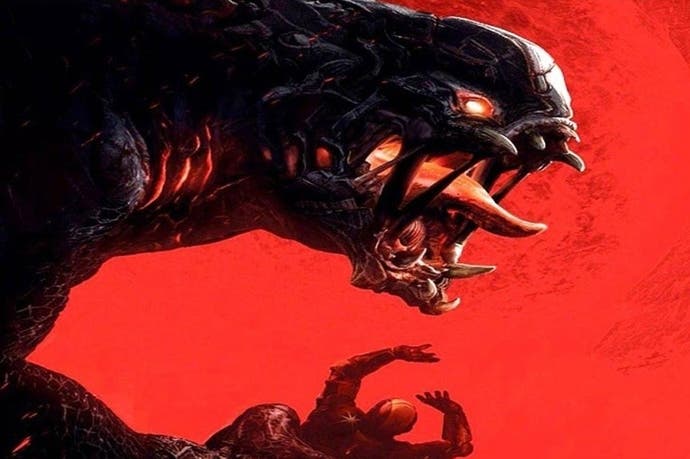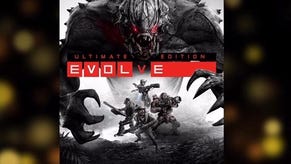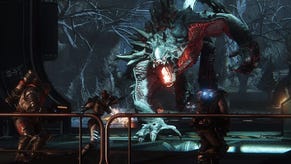Face-Off: Evolve
CryEngine compared on PS4, Xbox One and PC.
Previous builds of Turtle Rock's Evolve showed promise, thanks to the combination of impressive CryEngine-powered visuals and a unique take on the traditional team-based multi-player shooter - but at the same time the experience was let down by technical issues ranging from slow and inconsistent matchmaking to unstable netcode, leading to player disconnects. Launching with a massive 3GB day one update that promises to fix a wide range of bugs, alongside performance improvements, the good news is that the final version of Evolve provides a significantly better online experience than the pre-release code you may have already played.
Matchmaking across all formats is improved, with waiting times that usually take between a few seconds to two minutes, while lobby disconnects occur less frequently - though they are not completely eliminated. The Xbox One and PC versions of the game feel the most polished in these areas, with increased stability compared to the PS4 version. For example, matchmaking is a more inconsistent experience on Sony's system, often leaving you waiting between five and 20 minutes when things don't aren't quite working as they should. Rebooting the game usually takes care of the problem, although we noticed that the same problem usually crops up again after a few faultless matches.
General online performance during gameplay is also more stable, resulting in fewer disconnections and crashes, although both problems still appear on occasion. The end result is that the experience feels smoother and generally more consistent to play than before, with technical hiccups less frequently impacting the enjoyment of the game. That said, there are still a few issues: monsters have a tendency to clip through scenery on occasion during combat, while frame-rates often stutter heavily when a player is placed into an existing match, particularly if you get spawned right in the heart of battle. At one point we were also confronted with a major rendering bug on the Xbox One that projected environment shadows in mid air, flickering and floating in and out of view. Thankfully we only encountered this issue once over several hours of play, and it resolved itself on the next respawn.
From a technical perspective, the CryEngine-powered visuals in Evolve continue to impress, providing highly detailed worlds boasting dynamic lighting and weather conditions, along with a limited amount of destructible scenery - for example, trees are uprooted and wooden fences shredded to pieces. Physically-based rendering properties also allow surfaces to realistically simulate the reflection of light, completely changing the look of the environment under different weather conditions. Given the scalable nature of the CryEngine middleware, this level of quality extends across all three versions of Evolve, with the consoles featuring nearly all of the key effects the game has to offer. However, with full access to every map in the game, the PC version pulls ahead with additional effects in certain areas not found in either console build.
Alternative comparisons:
The console versions of Evolve use settings that closely match the PC version's high preset, with some areas enhanced and others pared back. Textures, shaders, and overall environment detail appear to run on high settings, while shadow quality and alpha buffers are set to very high, appearing identical to the PC game when maxed out. Other aspects, such as dynamic water caustics - which sees bullets and other objects create ripples and disruptions to the body of liquid - remain firmly intact across all formats. Curiously, environment reflections are entirely absent from water and wet surfaces on both PS4 and Xbox One, even though they appear on the PC game across all presets. On console, only light sources are reflected under similar conditions, with the more fully featured PC effect most likely cut for performance reasons.
While the core artwork is similar across all platforms, the PC game uses higher resolution textures for less important structures in the environment, lending more intricate detail on certain surfaces. Higher quality assets are also loaded in more quickly too, while LOD draw distances are slightly less aggressive. The main improvement comes with a small but noticeable boost to environment detail: the very high preset populates natural locations with more foliage, rocks, and organic debris giving many areas a more densely detailed appearance. This is most apparent in clearings that feature little greenery, where the extra rocks and greenery are clearly visible over the slightly more barren PS4 and Xbox One games. Very high or 'ultra' settings tend to be a case of massively diminishing returns, but Evolve is a noticeably richer experience maxed out on PC.
Naturally, the computer version operates at whatever resolution you choose to select, with the engine providing a range of anti-aliasing options. We elected for 1080p resolution to match the PS4 game, along with SMAA 1TX in order to provide the best image quality without adversely affecting performance. These settings deliver a very clean presentation while avoiding the ghosting issues present in the alpha and beta builds of the game when using SMAA. Indeed, the temporal ghosting has been reduced to the point where it no longer stands out clearly during gameplay, with the AA algorithm successfully smoothing over troublesome edges without blurring texture details. Interestingly, the option to use SMAA 2TX is gone, which is perhaps for the best bearing in mind its obtrusive ghosting effects noted during the pre-production phase.

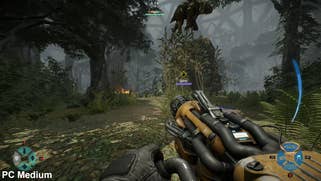





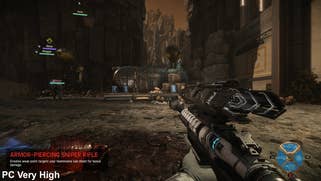


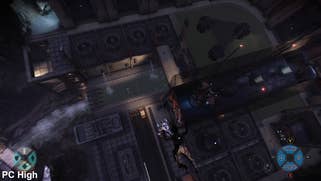

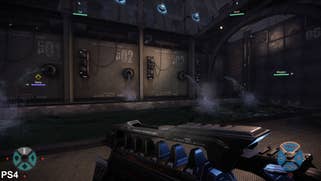
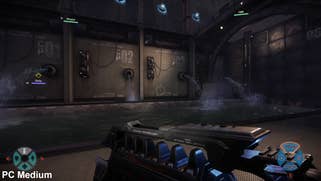
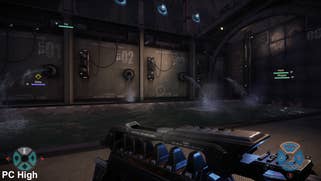
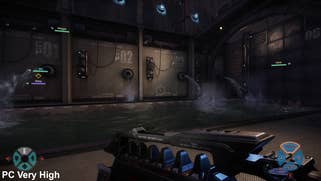
The core technical make up of Evolve on console hasn't changed from the previous alpha and beta builds: PS4 owners enjoy a very clean, native 1080p presentation, boasting few jaggies and edge artefacts outside of scenery heavy on sub-pixel detail, while the Xbox One game is based on a 900p framebuffer. For the most part the sub-1080p image works well on Microsoft's console, with the resolution difference appearing fairly subtle in the dark, low contrast environments - although the final image doesn't look quite as refined as the PS4 version. Anti-aliasing is provided by SMAA on both consoles (and it's very close to the PC's 1TX setting), playing an important part in the presentation and scaling up nicely on the Microsoft platform.
General graphical quality remains largely familiar too, with many of the same curious differences found in both the alpha and beta making their way across to the final game. The level of anisotropic filtering remains noticeably lower on the PS4, blurring texture details on the ground as a result, while streaming is often a little slower than Xbox One - particularly at the beginning of a game. While we see the same highly detailed artwork and shader effects bestowed across the lush landscapes and characters, lower quality LOD (level of detail) models are sometimes displayed for longer on PS4 compared to the other versions. In other areas, ambient occlusion is given a higher quality implementation on PS4 and PC, while the rest of the effects work - alpha buffers, shaders, and shadow quality - are a match between both consoles.
One of the standout graphical features of Evolve is the use of a dynamic weather system and real-time lighting model that dramatically changes the look of the environments during gameplay. Rain quickly soaks the stage in a shiny wetness that reflects surrounding light sources, creating pools of water across the ground, while blizzards provide great cover for monsters to deliver an unsuspecting attack. Light shafts are also present, their effects dependent on cloud coverage and the position of the sun. Some of these conditions are restricted to specific maps, so while it is possible to encounter snow on the Distillery level, you won't see it happening on Fusion Plant. Another nice touch is the inclusion of environmental conditions that only occur after certain events take place. For example, if the monster destroys the power reactor in Fusion Plant during the campaign mode, the next stage is covered in a green fog that is toxic to the hunters. You can manually select from a wide range of effects when setting up a custom match among friends.






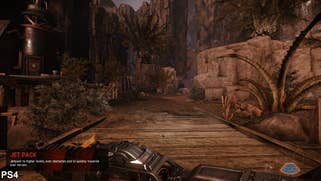
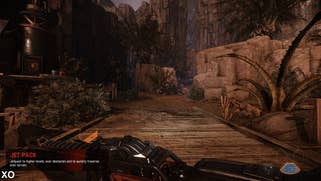
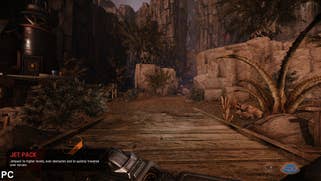
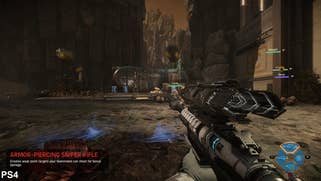
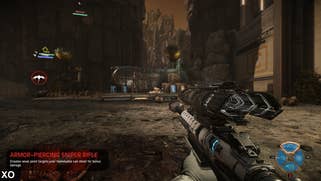


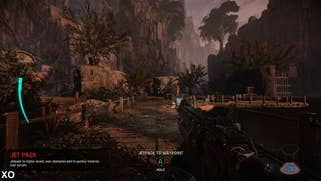

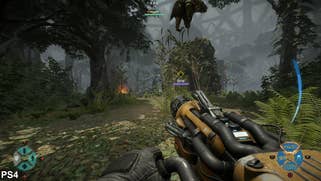
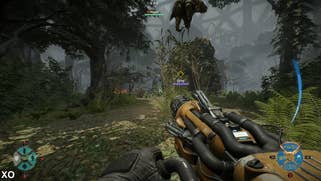
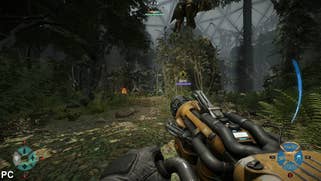

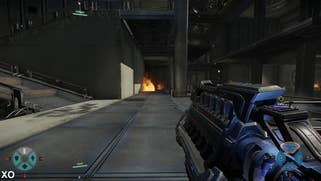
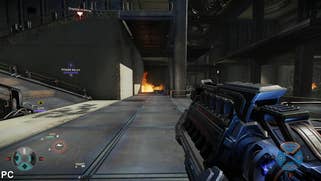
There are few surprises in terms of performance if you've been following our previous coverage of the game. While Xbox One and PS4 operate at different rendering resolutions, the frame-rate target is the same - 30fps with v-sync engaged with no tearing. The good news is that there's a boost to overall frame-rates compared to the previous builds, but there is one concerning issue we hope that Turtle Rock fixes as soon as possible. During gameplay we encounter short pauses that immediately break up the flow of the action, whether we're exploring the environment or engaging in combat. Frame-time measurements suggest that we're looking at 300-333ms pauses on both consoles - that's a third of a second where the game temporarily locks up. It's hardly a game-breaker, but it's somewhat disconcerting and never happened in the alpha or beta, which were both tested on the same internet connection.
It's not immediately clear what causes this to happen, since these stalls occur randomly, often when the engine isn't under form of extraordinary load. Instead, the phenomenon sometimes appears when the game brings up various HUD messages, and often randomly when nothing of note is occurring. What we can say is that with the code to hand, the Xbox One version seems to hitch like this more often than its PS4 equivalent.
Moving on to PC performance, it's fair to say that Evolve is fairly heavy on the GPU. Our "go to" system for console-equivalent performance features a Core i3 4130 matched with an entry-level enthusiast GTX 750 Ti and 8GB of RAM. Here, we see 25-30fps performance at 1080p with settings matched to the consoles as close as we can (everything on high, with very high shadows). To achieve console-level frame-rates, you'll need to blend medium and high quality settings, or else simply drop down to 1600x900 resolution. It's here that one of CryEngine's features is sorely missed - the in-built scaler found in Ryse allows you to downsample or upscale with excellent results, with HUD elements always running at native resolution. Its inclusion here would have been really useful.
Swapping out the GTX 750 Ti for a GTX 760, 1080p30 is easily attainable and there's room to push presets further. Performance increased significantly as moved up to the GTX 960, with frame-rates between 45-60fps, but the lack of consistency is off-putting, something that doesn't change even with an Intel quad-core processor in place.
CryEngine is seemingly compute-heavy and it's in this scenario that AMD graphics cards exert an advantage over their Nvidia counterparts. Moving onto mainstream enthusiast GPUs, we find that the R9 280 - a snip at around £140 - gets us very close to hitting 1080p60, with just a few drops in post-process heavy firefights. To achieve similar performance at the absolute highest settings, you're looking at high-end GPUs like the Radeon R9 290, R9 290X, GTX 970 and GTX 980. In combination with a quad-core Intel processor, all of these cards should blitz 1080p gameplay, and make a pretty good fist of handling 1440p too. We found that an overclocked GTX 970 and the stock GTX 980 run Evolve totally maxed at 2.5K resolution at between 50-60fps.
A big issue for PC gamers at the moment is VRAM utilisation, with GTX 970 owners in particular concerned about the smoke and mirrors surrounding their card's memory allocation. This is something we're looking at right now, but Evolve poses no problem here. Similar to Ryse - also powered by CryEngine - VRAM appears to be used as a huge cache. The more RAM you have, the more textures are cached. However, certainly at 1080p, the game seems to look very similar whether you have a 2GB card, 3GB or 4GB.
Evolve: the Digital Foundry verdict
Evolve has come a long way since we first played the Big Alpha in autumn last year, and there's a pleasing iterative improvement in all areas since the recent beta. The experience feels more polished, and it is possible to have a few prolonged sessions without any issues. However, underlying kinks remain and we feel that the game still requires another round of bug-fixing and optimisation before it has the consistency and stability that we want from an online-focused multiplayer title. Certainly, the split-second freezing issue - something we didn't see in the previous versions - must be resolved.
Hopefully Turtle Rock will sort out these issues in short order, but for now the CryEngine powered visuals remain excellent, lending both scope and atmosphere to the colonised alien environments, while the team-based gameplay offers plenty of depth, certainly in terms of mastering the unique abilities of each monster and finding out which hunter has an advantage in a particular situation.
It's a decent multi-platform project too, with Xbox One's 900p presentation holding up well against the native 1080p image of the PS4 game. However, the poorer quality filtering and slightly slower streaming doesn't always show the PS4 version of Evolve in the best light - but thankfully, in the darker environments these issues don't distract from the quality of the gameplay on offer. On the whole, both console versions are worthy of consideration and play identically for the most part. Making a firm recommendation on which to buy is a little challenging: the PS4's 1080p resolution gives it a slightly more refined experience, and performance is a little more stable too. However, this is an online-focused title and the backing infrastructure here doesn't seem quite as robust as it is on Xbox One and PC.
Overall, it's the PC version that potentially offers the best experience. There's the ability to scale beyond the 30fps cap found on console, with extra image quality and resolution options too. However, getting a good, consistent level of performance requires capable hardware, adroit settings management - or both in concert, depending on your system. Get it sorted though and the results can be quite beautiful - and certainly in a fast-paced shooter, 60fps gameplay trumps the console-standard 30fps experience.
